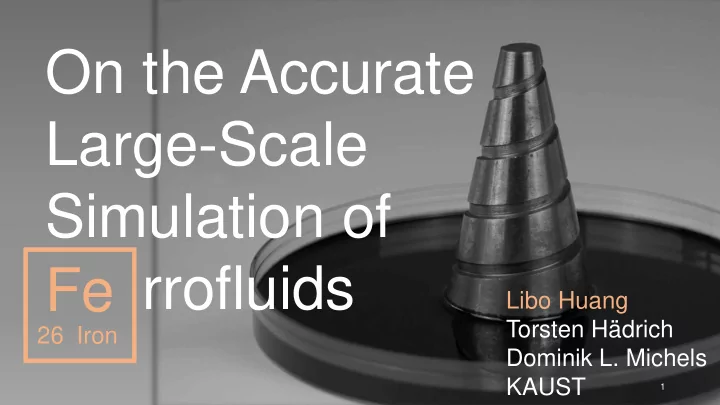

On the Accurate Large-Scale Simulation of rrofluids Fe Libo Huang Torsten Hädrich 26 Iron Dominik L. Michels KAUST 1
Real footage 2
Simulation Meshed View Particle View 3
Outline • Why it has spikes? • Related work • Our method (physically based) • Results & Discussion 4
No external magnetic field rrofluid Fe Iron 26 nanoparticles Fe 3 Ο 4 random direction 5
With external magnetic field dominant direction 6
With external magnetic field constant magnetic field 7
constant magnetic field 8
field 9
small bump stronger field 10
surface tension 11
Simulation Field Direction Surface Tension 12
𝐺 = 𝐺 surface + 𝐺 fluid + 𝐺 magnet 13
Particle Finite Element Method 14
Challenges Particle FEM • Approximating • Remeshing the continuous fluid and air ferrofluid • Accurate and stable magnetic forces 15
Our solution Only particles, no re-meshing 1. Smooth magnets, continuous fluid 2. Forces of smooth magnets, accurate, stable 3. Fast multipole method, 𝑃 𝑂 2 → 𝑃(𝑂) 16
Related Work From visual computing Ferrofluid: [Ishikawa et al. 2012, 2013] Rigid magnet: [Thomaszewski et al. 2008] Rigid magnet: [Kim et al. 2018] Post processing Rigid magnet Rigid magnet 17
Related Work From math & physics • [Nochetto et al. 2016] • [Yoshikawa et al. 2010] • [Lavrova et al. 2006, Gollwitzer 2006] 2D dynamic One spike Static 18
The simulator Explicit Scheme Smooth Particle 𝐺 Hydrodynamics fluid [Adami et al. 2012] SPH Surface Tension 𝐺(𝑢, 𝑦) 𝐺 𝑦(t) surface [Yang et al. 2017] Magnetic Solver 𝐺 magnet (ours) 19
Smooth Magnet 20
Smooth Point r r 0 0 Density Density Infinite small point Finite size cloud 𝐶(𝑠) ∝ 1 Near center 𝐶 𝑠 ∝ Density(𝑠) Near center 𝑠 3 𝐶(0) undefined 𝐶(0) well-defined 21
Point Smooth Discontinuous Continuous 22
Solve Magnetization Output: directions Input magnetic field 23
Solve Magnetization • Note: each smooth magnet affects others • An optimization problem: • Best dominant directions satisfy physics laws. • Least square conjugate gradient • Fast multipole, 𝑃 𝑂 2 → 𝑃(𝑂) 24
Force Principles 1. ∀ nanoparticle → magnetic field 2. ∀ nanoparticle ← magnetic forces 25
Center force Fitted force (point magnet (smooth magnet in smooth field) in smooth field) 26
Simulation Real footage 27
28
Simulation 29
Real footage 30
Simulation 31
Simulation 32
Simulation 33
Conclusion 3D dynamic ferrofluid simulator using smooth magnet. 34
On the Accurate Large-scale Simulation of Ferrofluids Libo Huang, Torsten Hädrich, Dominik L. Michels Questions? 35
Unintuitive Why simulating complex ferrofluids? geometry 39
Simulation 40
Target Source = Λ 𝑗𝑘𝑙 𝑠 𝑛 𝑡 𝑘 𝑛 𝑢 𝑗 𝑙 𝐺 𝑡→𝑢 In local coordinates A third-order tensor (to be measured) gives forces 49
Susceptibility ∝ Nanoparticle Density field 50
How to describe ferrofluid? Particle 𝑗 𝑛 𝑗 Magnitude × Direction = 𝑛 𝑗 ∈ ℝ 3 51
1. Particles Generate Magnetic Fields 𝑂 𝑂 fluid = fluid = 𝑐 𝑗 𝑐 𝐻 𝑗𝑘 𝑛 𝑘 𝑘→𝑗 𝑘=1 𝑘=1 𝐻 𝑗𝑘 ∈ ℝ 3×3 2. Magnetic Fields Influence Particles fluid + 𝑐 𝑗 external ) 𝑛 𝑗 = 𝑑(𝑐 𝑗 𝑑 ∈ ℝ ,constant 52
A correct particle state 𝑛 generates a field 𝑐 fluid , which combined with external field 𝑐 external lead to the same state 𝑛 . 𝑂 fluid = 𝑐 𝑗 𝐻 𝑗𝑘 𝑛 𝑘 𝑘=1 fluid + 𝑐 𝑗 external ) 𝑛 𝑗 = 𝑑(𝑐 𝑗 𝑛 − 𝑑 𝐻𝑛 + 𝑐 external min 2 𝑛 53
Center force: All nanoparticles moved to particle center to calculate force (bounded but inaccurate). Fitted force: All nanoparticles contribute to the force. Pre-calculated, stored as fitted polynomial (accurate surface force). 54
Fast Multipole Method Naive 30s 𝑐 = 𝐻𝑛 FMM 1.5s 55
Recommend
More recommend